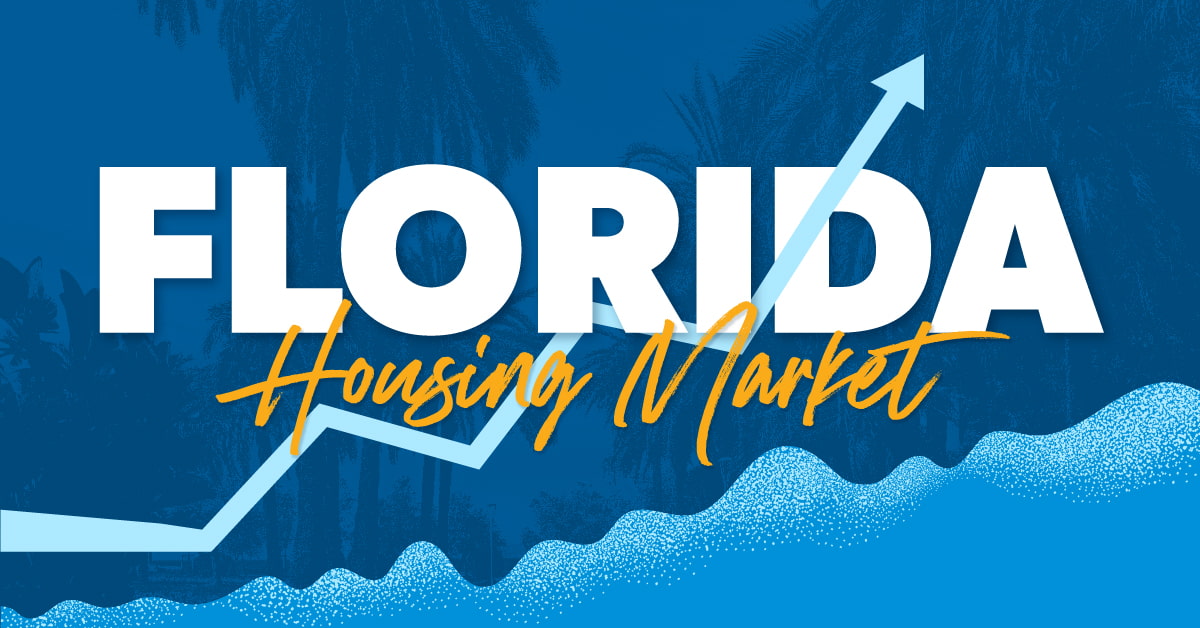
Key Takeaways
- Florida’s housing inventory continues to rise significantly, causing prices to drop—good news for buyers but a possible challenge for sellers.
- High homeowners insurance premiums in Florida may lower demand further, especially in areas prone to hurricanes, pushing prices down even more.
- U.S. mortgage interest rates are expected to dip slightly, reaching around 6.3% by the end of 2025, according to expert forecasts.
- A housing market crash in Florida remains unlikely, despite some worries about inflation and mortgage rates—according to the National Association of REALTORS®.
So, you’re tossing around the idea of packing up your bags and moving to Florida.
If you’re thinking about moving to the home of Disney World, the Daytona 500 and a 200-foot alligator-shaped building named Swampy (yep, that’s a real thing), you’re probably wondering about the Florida housing market. Well, you’re in luck! We dug into the latest news on the housing market in Florida to give you a heads-up on what to expect in the Sunshine State.
Now, the best way to learn about Florida’s market is to talk to a real estate agent who actually lives in Florida (you can find one through our RamseyTrusted® program), but these numbers and predictions will give you a good idea of what to look out for.
Ready to dive in? Let’s go!
What’s the Florida Housing Market Like?
Florida’s housing prices decreased in the first half of 2025—cooling off slightly. Here’s a quick peek at Florida’s single-family home prices, looking at June 2024 versus the recent June 2025 housing market data:
|
Florida Housing Market |
June 2025 |
June 2024 |
Percent Change |
|
Median Sale Price |
$412,000 |
$427,000 |
-3.5% |
|
Inventory (Active Listings) |
115,678 |
93,105 |
+24.2% |
|
Closed Sales |
23,827 |
23,183 |
+2.8% |
|
Median Time to Sale |
86 days |
78 days |
+8 Days1 |
|
Average U.S. Mortgage Rate (15-Year Fixed) |
5.95% |
6.19% |
-0.24 Percentage Points2 |
Florida Housing Market in Major Cities
Sometimes, looking at Florida’s statewide housing trends doesn’t give you the full picture of what’s really happening in the local markets. To get a clear snapshot of Florida’s housing market at the end of Q1 2025, let’s dive into recent housing trends in three major cities: Orlando, Tampa and Jacksonville.
|
|
Orlando |
Tampa |
Jacksonville |
|
Median Sale Price (Q1 2025) |
$445,000 |
$400,000 |
$390,000 |
|
Percent Change Since Q1 2024 |
+2.3% |
-1.3% |
0%3 |
How Does Florida Compare to the National Housing Market?
Let’s talk about how Florida’s real estate market compares to the U.S. as a whole.
At the national level, the median home sale price is $435,300.4 As we saw earlier, Florida’s median sale price is less expensive at $412,734—about 5.2% lower than the typical national price.
Florida Housing Market Predictions for 2025
Okay—we’ve crunched the housing numbers. Now, let’s turn our attention to what some real estate gurus are predicting about Florida’s housing for the rest of 2025.
1. Inventory Will Continue Increasing
Let’s throw it back to high school economics for just a second. You may remember that when supply decreases and demand stays the same, prices go up. Well, that’s exactly what’s happened in the real estate market across the U.S. over the past few years.
Home prices have shot through the roof—mostly because there just aren’t enough houses on the market. And while housing inventory is on the uptick across the country, the increase isn’t happening fast enough to lower prices in most places.
At least one state is an exception though: Florida. Housing inventory in the Florida real estate market increased enough in 2024 to make prices fall, and that trend could continue into 2025. Just ask Tim Weisheyer, 2025 Florida REALTORS® President.
“Florida’s home buyers and sellers are continuing to adjust to the normalization of the state’s housing market, a welcome sign for those who have been waiting for more inventory and a cooling off of the incredibly hot market we have had over the past few years,” he said. “More for-sale inventory creates increased opportunities for homeownership.”5
While continued increase in inventory will make life more difficult for sellers, it’s a great development for buyers.
2. High Insurance Premiums Will Limit Demand
High house prices and interest rates aren’t the only things making homeownership in Florida expensive—the cost of homeowners insurance has also skyrocketed. In fact, recent data reports an effective rate change increase of 54% from 2019 to 2024!6
That’s crazy! And it’s making homeownership way too pricey for a lot of folks, especially in areas prone to hurricanes—one of the biggest reasons for the steep increase.
As a result, demand in the Florida housing market could decrease, which would lead to prices going down further. With the potential for rising inventory and declining demand, 2025 should be a great time to buy a house in Florida if you’re financially ready (more on that later).
3. Interest Rates Should Lower Slightly
According to Fannie Mae’s March 2025 forecast, U.S. 30-year mortgage rates will likely close out 2025 at 6.3%, dropping further to 6.2% by the end of 2026.7
“While our latest forecast calls for a period of modestly slower economic growth, historically, interest rates have been the most important driver of home sales,” reported Mark Palim, Fannie Mae’s senior vice president and chief economist. “We think mortgage rates will move even lower within the next quarter and ultimately close the year at approximately 6.3%, which could be low enough to generate some extra sales from any would-be buyers still waiting on the sidelines.”8
Basically, we’re unlikely to see any dramatic rates changes anytime soon, so trying to “time” the market perfectly can lead to missed opportunities. If you’re ready to buy and your finances are in order, don’t let minor rate changes hold you back. Focus on what you can control—your budget and your goals. The best time to buy is when you’re ready.
Don’t buy or sell without an agent you can trust.
There are RamseyTrusted real estate agents all over the country who are ready to help you win.
Will the Housing Market Crash in Florida?
Wondering if Florida (or the rest of the U.S.) is headed toward a housing crash in 2025? You can take a deep breath—experts say it’s unlikely. Despite some concerns around mortgage rates and inflation, current analyses suggest a modest growth instead of a big downturn.
Even though the National Association of REALTORS® (NAR) noted a 4.6% drop in pending home sales back in January, chief economist Lawrence Yun reassured potential buyers, explaining:
“A sharp rise in mortgage rates to around 9%, combined with significant net job losses, could put severe pressure on the housing market. However, both scenarios are unlikely, making a market crash unlikely.”9
Is It a Good Time to Buy or Sell a House in Florida in 2025?
All right, we’ve looked at a whole lot of stats, trends and predictions for the Florida real estate market. As we wrap up, you probably have one important question on your mind: Should I buy or sell in Florida this year? Let’s talk about it.
Based on the market, 2025 should be a great time to buy a house in Florida. Like we talked about earlier, increasing inventory and decreasing prices should give buyers a pretty good boost. On the other hand, sellers may find the market a bit trickier to navigate.
But here’s the deal: You shouldn’t let the housing market control your decision on whether to buy or sell right now. It’s important to understand real estate trends so you have some context, but you should base your decision on your individual situation.
For example, if you’re buying a house, you need to make sure you’re financially prepared. That means you’re debt-free, you have a fully funded emergency fund with 3–6 months of expenses, and you’ve saved up enough cash to make a down payment of at least 20%. (If you’re first-time buyer, 5–10% is okay—just be prepared to pay for private mortgage insurance.)
And if you’re selling a house, you need to make sure you can afford the move and that doing so won’t hurt your financial situation. It also wouldn’t be a bad idea to line up a new place to live—though you never want to buy a new house before selling your old one.
Bottom line: You are in control of whether it’s a good time for you to buy or sell a house in Florida—not the market.
Next Steps
- Are you ready to buy or sell your home? Take our free quiz to find out!
- If you’re ready, connect with a RamseyTrusted real estate agent in Florida. We handpick and regularly coach our agents to meet our high standards of excellence—so you can trust them to serve you well (that’s why they’re called RamseyTrusted!).
Did you find this article helpful? Share it!

We Hear You!
We’re considering adding the ability to save articles to your Ramsey account.




